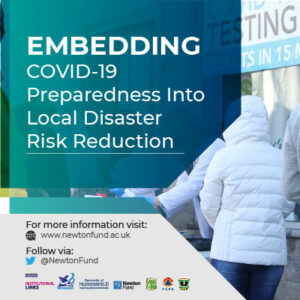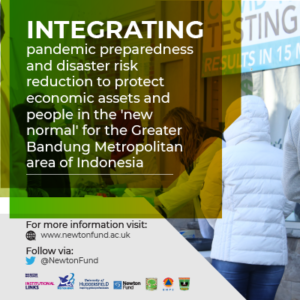COVID 19 LIAISE - Project 02
Integrating pandemic preparedness and disaster risk reduction to protect economic assets and people in the 'new normal' for the Greater Bandung Metropolitan area of Indonesia
Previous Work
Previous work is a collaboration between the Department of Urban and Regional Planning, Bandung Institute of Technology, Indonesia and the Global Disaster Resilience Centre (GDRC) at the University of Huddersfield, UK.
This collaboration and research project will develop researcher capacity and novel, integrated DDR and CCA strategies that can protect centres of economic growth and development outcomes in coastal urban agglomerations. Through documented Indonesia case studies and international good practices, and a stakeholder map of DRR and CCA actors at the city level, the project will develop a multi stakeholder transition pathway and a clear policy statement on mainstreaming DRR and CCA in Indonesia’s coastal urban agglomeration development plan.
The project will reduce disaster risk, including human and economic losses, and create more resilient, connected communities. It will foster multi-stakeholder involvement in development processes and equal participation of groups who are often excluded, such as women, children and youth, and people with disabilities. It will directly contribute to Indonesia’s efforts in working towards the targets set out in the global agreements on disaster risk reduction (Sendai Framework), Climate Change (COP21) and Sustainable Development Goals.
Visit our website for more details: http://nuar.info/node/1
How new project has built upon previous work
Extend the user engagement and impact to Greater Bandung, Indonesia The new project will apply findings that emerged from the previous Newton study on coastal agglomerations in Jakarta and Sarbagita to a region with a very different topography, hazard profile and economic base. It will increase user engagement and impact of the previous work by translating the multi-stakeholder transition pathway to the needs of the Greater Bandung Metropolitan, including the City of Bandung (all 30 districts), City of Cimahi (all 3 districts), Bandung Regency (all 31 districts), and West Bandung Regency (all 16 districts) and part of Sumedang Regency (5 districts), with a total area more than 5,500 km2 and a population greater than 11 million people. Greater Bandung plays important role as one of national economic corridors and the hub of think tank for the national development. In contrast to the previous studies on coastal regions, Greater Bandung, also known as Bandung Basin, is located in a mountainous plateau region in the central-west portion of West Java province and has the third highest population of any metropolitan area in Indonesia. The agglomeration is surrounded by active volcanoes, a number of faults and complex river systems that pose significant hazards, including earthquakes, volcano eruptions, frequent floods and landslides. The economy of the region is built on education, tourism, manufacturing, textile/apparel, retail, services, plantation/agriculture, food, financial, healthcare, pharmaceuticals including vaccines.
The new project will increase policy impacts by extending the scope of the previous Newton study on DRR and CCA integration in urban agglomerations to address the additional challenges posed by COVID-19 and similar future pandemic threats. The Sendai Framework endorses not only reducing existing risk, but also new and emerging risk. The global spread of COVID-19 has overwhelmed health systems, but also caused widespread social and economic disruption. By putting societies and economies on hold, many countries, including Indonesia, have curtailed the ability of the virus to spread. These defensive measures have helped to limit the short-term impacts, but also resulted in a shift of priorities, alterations in work processes and venues, physical distancing, self-isolation and quarantine measures, as well as temporary lockdowns. These tend to disproportionately affect disadvantaged groups, including people in poverty and migrants, who most often live in overcrowded and under resourced settings, and depend on daily labour for subsistence.
These COVID-19 measures have also exposed gaps in many countries’ DRR strategies, which often fail to address pandemics despite them being an explicit goal of Sendai. This type of threat does not respect administrative boundaries and exposes the interconnectedness of economic and social activity. At an institutional level, government agencies are already stretched trying to manage the COVID-19 response. How are measures coordinated across administrative boundaries? How can agglomerations ensure a safe transition to the “new normal”? How would government, systems and people cope if a major flood, landslide or eruption event occurs while the COVID-19 pandemic continues?
COVID-19 protocols may also create ambiguity or confusion downstream with regards to other hazard warning services, as well as with response actions like evacuation. Rapid-onset hazards not only require immediate action by official authorities to provide warnings and initiate evacuation processes but may also require quick and autonomous decisions on the part of the population for self-evacuation. At the same time, there are opportunities for pandemic preparedness and response to make better use of the existing infrastructure, including downstream early warning protocols and risk communication processes.

